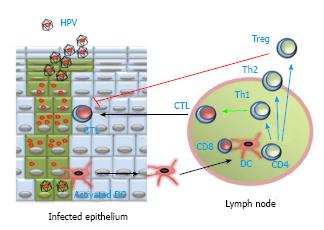Copyright
©2014 Baishideng Publishing Group Inc.
World J Clin Oncol. Dec 10, 2014; 5(5): 1002-1019
Published online Dec 10, 2014. doi: 10.5306/wjco.v5.i5.1002
Published online Dec 10, 2014. doi: 10.5306/wjco.v5.i5.1002
Figure 3 Cellular immune response against human papilloma virus.
Dendritic cells (DC) can take human papilloma virus (HPV) antigens from the infected epithelium, and then migrate (black arrows) to lymph nodes. There, DC present the processed antigen together with MHC class I and class II molecules, to CD8+ T cells and CD4+ T cells, respectively. CD4+ T cells proliferate and differentiate (blue arrows) into T helper cells, either Th1 or Th2, depending on the type of cytokines they produce. CD8+ T cells differentiate (blue arrow), with help (green arrow) from Th1 cells, into cytotoxic T cells (CTL). Then, CTL migrate (black arrow) back to the infected epithelium to destroy virus-infected cells. CD4+ T cells can also differentiate (blue arrow) into regulatory T cells (Treg), which inhibit (red line) the cytotoxic activity of CTL.
- Citation: Rosales R, Rosales C. Immune therapy for human papillomaviruses-related cancers. World J Clin Oncol 2014; 5(5): 1002-1019
- URL: https://www.wjgnet.com/2218-4333/full/v5/i5/1002.htm
- DOI: https://dx.doi.org/10.5306/wjco.v5.i5.1002









